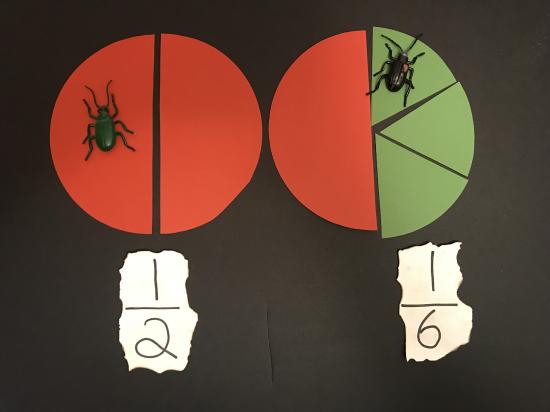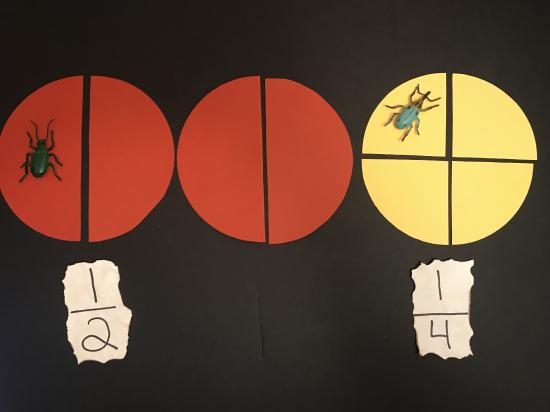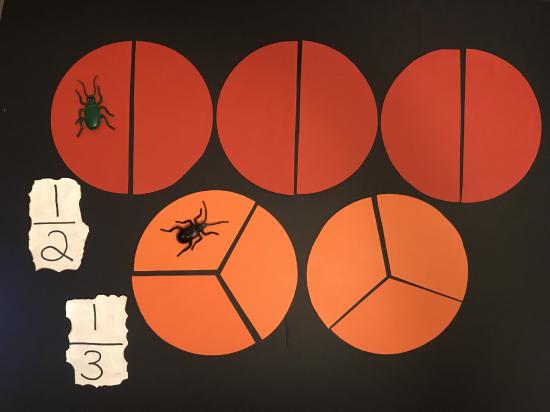7.2: Egyptian Fractions
- Page ID
- 13632
This page is a draft and is under active development.
\( \newcommand{\vecs}[1]{\overset { \scriptstyle \rightharpoonup} {\mathbf{#1}} } \)
\( \newcommand{\vecd}[1]{\overset{-\!-\!\rightharpoonup}{\vphantom{a}\smash {#1}}} \)
\( \newcommand{\dsum}{\displaystyle\sum\limits} \)
\( \newcommand{\dint}{\displaystyle\int\limits} \)
\( \newcommand{\dlim}{\displaystyle\lim\limits} \)
\( \newcommand{\id}{\mathrm{id}}\) \( \newcommand{\Span}{\mathrm{span}}\)
( \newcommand{\kernel}{\mathrm{null}\,}\) \( \newcommand{\range}{\mathrm{range}\,}\)
\( \newcommand{\RealPart}{\mathrm{Re}}\) \( \newcommand{\ImaginaryPart}{\mathrm{Im}}\)
\( \newcommand{\Argument}{\mathrm{Arg}}\) \( \newcommand{\norm}[1]{\| #1 \|}\)
\( \newcommand{\inner}[2]{\langle #1, #2 \rangle}\)
\( \newcommand{\Span}{\mathrm{span}}\)
\( \newcommand{\id}{\mathrm{id}}\)
\( \newcommand{\Span}{\mathrm{span}}\)
\( \newcommand{\kernel}{\mathrm{null}\,}\)
\( \newcommand{\range}{\mathrm{range}\,}\)
\( \newcommand{\RealPart}{\mathrm{Re}}\)
\( \newcommand{\ImaginaryPart}{\mathrm{Im}}\)
\( \newcommand{\Argument}{\mathrm{Arg}}\)
\( \newcommand{\norm}[1]{\| #1 \|}\)
\( \newcommand{\inner}[2]{\langle #1, #2 \rangle}\)
\( \newcommand{\Span}{\mathrm{span}}\) \( \newcommand{\AA}{\unicode[.8,0]{x212B}}\)
\( \newcommand{\vectorA}[1]{\vec{#1}} % arrow\)
\( \newcommand{\vectorAt}[1]{\vec{\text{#1}}} % arrow\)
\( \newcommand{\vectorB}[1]{\overset { \scriptstyle \rightharpoonup} {\mathbf{#1}} } \)
\( \newcommand{\vectorC}[1]{\textbf{#1}} \)
\( \newcommand{\vectorD}[1]{\overrightarrow{#1}} \)
\( \newcommand{\vectorDt}[1]{\overrightarrow{\text{#1}}} \)
\( \newcommand{\vectE}[1]{\overset{-\!-\!\rightharpoonup}{\vphantom{a}\smash{\mathbf {#1}}}} \)
\( \newcommand{\vecs}[1]{\overset { \scriptstyle \rightharpoonup} {\mathbf{#1}} } \)
\( \newcommand{\vecd}[1]{\overset{-\!-\!\rightharpoonup}{\vphantom{a}\smash {#1}}} \)
\(\newcommand{\avec}{\mathbf a}\) \(\newcommand{\bvec}{\mathbf b}\) \(\newcommand{\cvec}{\mathbf c}\) \(\newcommand{\dvec}{\mathbf d}\) \(\newcommand{\dtil}{\widetilde{\mathbf d}}\) \(\newcommand{\evec}{\mathbf e}\) \(\newcommand{\fvec}{\mathbf f}\) \(\newcommand{\nvec}{\mathbf n}\) \(\newcommand{\pvec}{\mathbf p}\) \(\newcommand{\qvec}{\mathbf q}\) \(\newcommand{\svec}{\mathbf s}\) \(\newcommand{\tvec}{\mathbf t}\) \(\newcommand{\uvec}{\mathbf u}\) \(\newcommand{\vvec}{\mathbf v}\) \(\newcommand{\wvec}{\mathbf w}\) \(\newcommand{\xvec}{\mathbf x}\) \(\newcommand{\yvec}{\mathbf y}\) \(\newcommand{\zvec}{\mathbf z}\) \(\newcommand{\rvec}{\mathbf r}\) \(\newcommand{\mvec}{\mathbf m}\) \(\newcommand{\zerovec}{\mathbf 0}\) \(\newcommand{\onevec}{\mathbf 1}\) \(\newcommand{\real}{\mathbb R}\) \(\newcommand{\twovec}[2]{\left[\begin{array}{r}#1 \\ #2 \end{array}\right]}\) \(\newcommand{\ctwovec}[2]{\left[\begin{array}{c}#1 \\ #2 \end{array}\right]}\) \(\newcommand{\threevec}[3]{\left[\begin{array}{r}#1 \\ #2 \\ #3 \end{array}\right]}\) \(\newcommand{\cthreevec}[3]{\left[\begin{array}{c}#1 \\ #2 \\ #3 \end{array}\right]}\) \(\newcommand{\fourvec}[4]{\left[\begin{array}{r}#1 \\ #2 \\ #3 \\ #4 \end{array}\right]}\) \(\newcommand{\cfourvec}[4]{\left[\begin{array}{c}#1 \\ #2 \\ #3 \\ #4 \end{array}\right]}\) \(\newcommand{\fivevec}[5]{\left[\begin{array}{r}#1 \\ #2 \\ #3 \\ #4 \\ #5 \\ \end{array}\right]}\) \(\newcommand{\cfivevec}[5]{\left[\begin{array}{c}#1 \\ #2 \\ #3 \\ #4 \\ #5 \\ \end{array}\right]}\) \(\newcommand{\mattwo}[4]{\left[\begin{array}{rr}#1 \amp #2 \\ #3 \amp #4 \\ \end{array}\right]}\) \(\newcommand{\laspan}[1]{\text{Span}\{#1\}}\) \(\newcommand{\bcal}{\cal B}\) \(\newcommand{\ccal}{\cal C}\) \(\newcommand{\scal}{\cal S}\) \(\newcommand{\wcal}{\cal W}\) \(\newcommand{\ecal}{\cal E}\) \(\newcommand{\coords}[2]{\left\{#1\right\}_{#2}}\) \(\newcommand{\gray}[1]{\color{gray}{#1}}\) \(\newcommand{\lgray}[1]{\color{lightgray}{#1}}\) \(\newcommand{\rank}{\operatorname{rank}}\) \(\newcommand{\row}{\text{Row}}\) \(\newcommand{\col}{\text{Col}}\) \(\renewcommand{\row}{\text{Row}}\) \(\newcommand{\nul}{\text{Nul}}\) \(\newcommand{\var}{\text{Var}}\) \(\newcommand{\corr}{\text{corr}}\) \(\newcommand{\len}[1]{\left|#1\right|}\) \(\newcommand{\bbar}{\overline{\bvec}}\) \(\newcommand{\bhat}{\widehat{\bvec}}\) \(\newcommand{\bperp}{\bvec^\perp}\) \(\newcommand{\xhat}{\widehat{\xvec}}\) \(\newcommand{\vhat}{\widehat{\vvec}}\) \(\newcommand{\uhat}{\widehat{\uvec}}\) \(\newcommand{\what}{\widehat{\wvec}}\) \(\newcommand{\Sighat}{\widehat{\Sigma}}\) \(\newcommand{\lt}{<}\) \(\newcommand{\gt}{>}\) \(\newcommand{\amp}{&}\) \(\definecolor{fillinmathshade}{gray}{0.9}\)The Egyptians used a pictorial number system, with different symbols for every power of 10 to 1 000 000.
1 = |
4 = ||||
10 = ∩
23 = ∩ ∩|||
100 =
112 = ∩||
Egyptian fractions can only have 1 as the numerator: \( \dfrac{1}{4}, \dfrac{1}{16}, \dfrac{1}{137}\) etc. This can also be called unit fractions. (They also used \( \dfrac{2}{3} \) but we will ignore this for now). The unit fraction is made by writing the number with a “mouth” symbol over the top –
\(\dfrac{1}{2}=\)
Egyptians did not like repeating fractions, therefore, each fraction must be unique. As a result, any fraction with numerator > 1 must be written as a combination of some set of Egyptian fractions. As a result of this mathematical quirk, Egyptian fractions are a great way to test student understanding of adding and combining fractions with different denominators (grade 5-6), and for understanding the relationship between fractions with different denominators (grade 5). We can use manipulative to explore Egyptian fractions. For a detailed activity, please see Activity.
Eye of Honus
Party Time
Example \(\PageIndex{1}\): Party Time
You're having a pie party. Unfortunately, you forgot to cut the pies before the party started. How do you cut and split the pies evenly amongst your guests, if there are 3 people and 2 pies \( \dfrac{2}{3} \)? How do you split the pies using Egyptian fractions?
Solution
Using our manipulative, we begin by laying out 2 full pies. The biggest Egyptian fraction that can split these pies is \(\dfrac{1}{2}\). This gives us \(\dfrac{1}{2}\) of a pie for each person and \(\dfrac{1}{2}\) of a pie leftover. We can split this last half piece into thirds again, giving us \(\dfrac{1}{6}\) of a pie for each person. That is \( \dfrac{2}{3}= \dfrac{1}{2} +\dfrac{1}{6} \).

Example \(\PageIndex{2}\):
If we were asked to write \( \dfrac{3}{5} \) into a sum of Egyptian fractions, we could write \( \dfrac{1}{5} + \dfrac{1}{5}+ \dfrac{1}{5} \), since each fraction has a numerator of 1. The only problem with this is that they aren't unique fractions, therefore it wouldn't work for the sum of Egyptian fractions.
\( \dfrac{3}{5} = \dfrac{1}{2}+ \dfrac{1}{10} \).
Example \(\PageIndex{3}\):
What if there were only 4 pizzas to be split amongst 8 friends?
\( \dfrac{5}{8} = \dfrac{1}{2}+ \dfrac{1}{8} .\)
Exercise \(\PageIndex{1}\):
You're having a pie party. Unfortunately, you forgot to cut the pies before the party started. How
do you cut and split the pies evenly amongst your guests?
- There are 4 people and 3 pies \(\dfrac{3}{4} \). How do you split the pies using Egyptian fractions?
- There are 6 people and 5 pies \( \dfrac{5}{6} \). How do you split the pies using Egyptian fractions?
- Answer
-
1. Using our manipulative, we begin by laying out 3 full pies. The biggest Egyptian fraction that can split these pies is \(\dfrac{1}{2}\).
This gives us \(\dfrac{1}{2}\) a pie for each person and a whole pie leftover. We can split this pie into 4 equal pieces, giving us \(\dfrac{1}{4}\) of a pie for each person.
2. Using our manipulative, we begin by laying out \(5\) full pies. The biggest Egyptian fraction that can split these pies is \(\dfrac{1}{2}\).
This gives us \(\dfrac{1}{2}\) a pie for each person and two whole pie leftovers. We can split these two pies into 6 equal pieces, giving us \(\dfrac{1}{3}\) of a pie for each person.
Bigger Parties, Bigger Problems
You are now having an even bigger party with a lot more pies. Can you find the sum of Egyptian fractions that will help split the pies evenly amongst your guests? Having manipulative for these next questions would be unrealistic as there would be too many pies. Instead, we can think about the factors of 100 and use these as our denominators of our Egyptian fractions.The factors of \(100\) are \(1, 2, 4, 5, 10, 20, 25, 50, \) and \(100.\)
Example \(\PageIndex{4}\):
There are \(100\) people and \(91\) pies \( \dfrac{91}{100} \). How do you split the pies using Egyptian fractions?
Solution
Looking at our factors of \(100\), we can begin by subtracting the biggest Egyptian fraction \(\dfrac{1}{2}\).
\( \dfrac{91}{100}-\dfrac{1}{2}= \dfrac{91}{100}-\dfrac{50}{100}=\dfrac{41}{100} \).
Next, we subtract \( \dfrac{1}{4}\).
\( \dfrac{41}{100}-\dfrac{1}{4}= \dfrac{41}{100}-\dfrac{25}{100}=\dfrac{16}{100} \).
Notice that we can't subtract Next, we subtract \( \dfrac{1}{5}= \dfrac{20}{100}\). Therefore, we subtract \( \dfrac{1}{10}\).
\( \dfrac{16}{100}-\dfrac{1}{10}= \dfrac{16}{100}-\dfrac{10}{100}=\dfrac{6}{100} \).
Next we subtract \(\dfrac{1}{20}\).
\( \dfrac{6}{100}-\dfrac{1}{20}= \dfrac{6}{100}-\dfrac{5}{100}=\dfrac{1}{100} \).
Thusm \( \dfrac{91}{100}=\dfrac{1}{2}+ \dfrac{1}{4}+\dfrac{1}{5}+\dfrac{1}{100} \). Each person would get \(\dfrac{1}{2}, \dfrac{1}{4}, \dfrac{1}{5}.\) and \(\dfrac{1}{100}\) of a pie.
Exercise \(\PageIndex{2}\):
There are \(100\) people and \(99\) pies \( \dfrac{99}{100} \). How do you split the pies using Egyptian fractions?
- Answer
-
\( \dfrac{99}{100}=\dfrac{1}{2}+ \dfrac{1}{4}+\dfrac{1}{5}+\dfrac{1}{25} \). Also note that it can be spilit into Egyptian fractions which do not have their denominators as factors of 100. \( \dfrac{99}{100}=\dfrac{1}{2}+ \dfrac{1}{3}+\dfrac{1}{10}+\dfrac{1}{20}+ \dfrac{1}{150} \).
Theorem \(\PageIndex{1}\)
Any fraction \( \dfrac{2}{n}\), where \(n\) is odd, can be expressed as a sum of two Egyptian fractions.
- Proof
-
coming soon.
- Thanks to Jillian Periliat for all the diagrams.
SOURCE
- By Ad Meskens [CC BY-SA 3.0 (https://creativecommons.org/licenses/by-sa/3.0) or GFDL (http://www.gnu.org/copyleft/fdl.html)], from Wikimedia Commons

